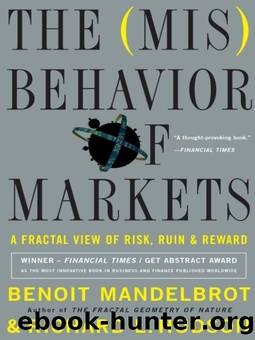The Misbehavior of Markets: A Fractal View of Financial Turbulence by Benoit Mandelbrot

Author:Benoit Mandelbrot
Language: eng
Format: mobi
Publisher: Basic Books
Published: 2011-02-23T21:00:00+00:00
The Meaning of Cotton
But why was the economics establishment so alarmed by the cotton research in the first place?
Remember the standard models. If the cotton price-changes fit the standard theory, they would be like sand grains in a heap; somewhat different sizes, but all sand grains, nonetheless. My cotton research showed something different: The changes were more like a mixture of sand, pebbles, rocks, and boulders. Some days, cotton prices hardly budged from the previous close; those are the small sand grains. Other days, the prices leaped a few percentage points; those are the boulders. Some days, there was no news in the market: quiet prices, sand grains again. Other days—perhaps word of a drought in Missouri finally reached New York—the news was big: wild price moves, statistical boulders. Together, all this news big and small, all these price-changes big and small, mix together in the crucible of a marketplace.
Fine, you may say. That explains the “fat tails,” or abnormally big changes, in the cotton prices. But over a few years of daily trading, or a century of monthly trading, the same pattern emerges that you can see, with your own eyes, on a simple sheet of paper. Why the scaling? What does it mean that the price-changes scale?
Here, I can only speculate. In the physics I learned as a student, there is a clear barrier between the very large and the very small. At the very large scale of the cosmos, the relativistic space-time laws of Einstein apply. In the medium-scale world of our daily lives, Newtonian mechanics holds. And in the subatomic world of electrons and quarks, the entirely different laws of quantum mechanics apply. Three different regimes, three different scales, each one distinct from the last. The laws of physics do not scale. Shortly after my cotton papers (and quite independently), statistical physics expanded to study phenomena called “critical.” It ignored and contradicted Zipf’s distinction between physical and social science by discovering scaling relations of its own and fully explained them on the basis of unquestioned mathematical properties of matter. But economics is different. It lacks unquestioned mathematical laws to rely upon. Also, time, not space, is the scaling factor. Some timespans matter, of course. In cotton, the annual cycle of planting and harvesting has a regular, periodic effect on trading; cotton stocks rise at harvest and trend downward until the next harvest. It is predictable. Economists routinely factor it out of their long-term analyses. But once the data are seasonally adjusted, is there any other time-scale that has a direct impact on cotton prices? After seasonal adjustment, is there anything in economics like the gulf between the quantum and Newtonian worlds? Do three weeks of trading really happen on a different economic planet than three days of trading, or three hours? Clearly not. All charts look the same.
Gaussian or not, scaling or not: Does it matter? Yes. First, it shows that prices can and do gyrate wildly. The market is very risky—far more risky than if you blithely assume that prices meander around a polite Gaussian average.
Download
This site does not store any files on its server. We only index and link to content provided by other sites. Please contact the content providers to delete copyright contents if any and email us, we'll remove relevant links or contents immediately.
| Biomathematics | Differential Equations |
| Game Theory | Graph Theory |
| Linear Programming | Probability & Statistics |
| Statistics | Stochastic Modeling |
| Vector Analysis |
Modelling of Convective Heat and Mass Transfer in Rotating Flows by Igor V. Shevchuk(6202)
Weapons of Math Destruction by Cathy O'Neil(5779)
Factfulness: Ten Reasons We're Wrong About the World – and Why Things Are Better Than You Think by Hans Rosling(4454)
Descartes' Error by Antonio Damasio(3139)
A Mind For Numbers: How to Excel at Math and Science (Even If You Flunked Algebra) by Barbara Oakley(3076)
Factfulness_Ten Reasons We're Wrong About the World_and Why Things Are Better Than You Think by Hans Rosling(3025)
TCP IP by Todd Lammle(2982)
Applied Predictive Modeling by Max Kuhn & Kjell Johnson(2859)
Fooled by Randomness: The Hidden Role of Chance in Life and in the Markets by Nassim Nicholas Taleb(2834)
The Tyranny of Metrics by Jerry Z. Muller(2819)
The Book of Numbers by Peter Bentley(2744)
The Great Unknown by Marcus du Sautoy(2516)
Once Upon an Algorithm by Martin Erwig(2457)
Easy Algebra Step-by-Step by Sandra Luna McCune(2435)
Lady Luck by Kristen Ashley(2386)
Practical Guide To Principal Component Methods in R (Multivariate Analysis Book 2) by Alboukadel Kassambara(2358)
Police Exams Prep 2018-2019 by Kaplan Test Prep(2334)
All Things Reconsidered by Bill Thompson III(2242)
Linear Time-Invariant Systems, Behaviors and Modules by Ulrich Oberst & Martin Scheicher & Ingrid Scheicher(2210)
